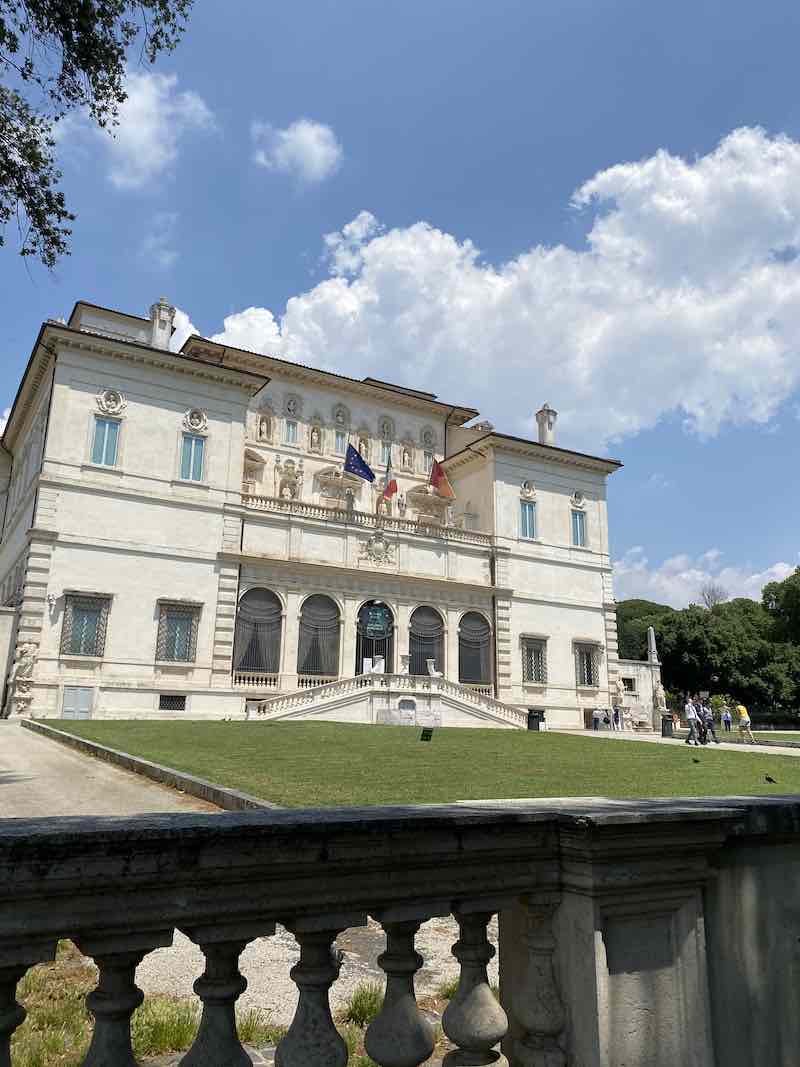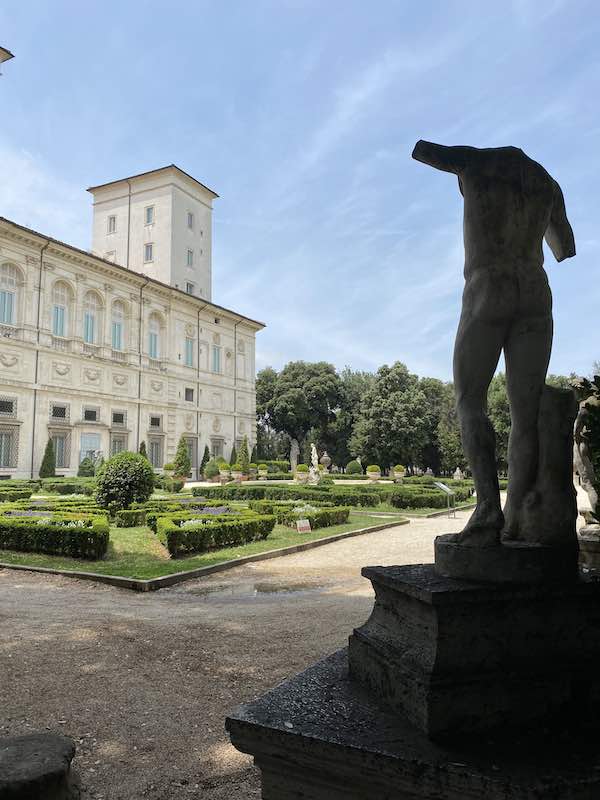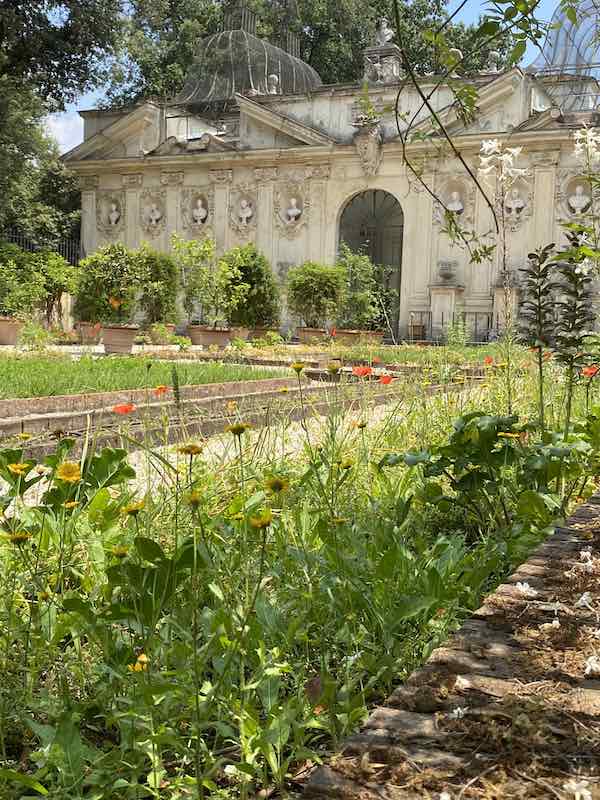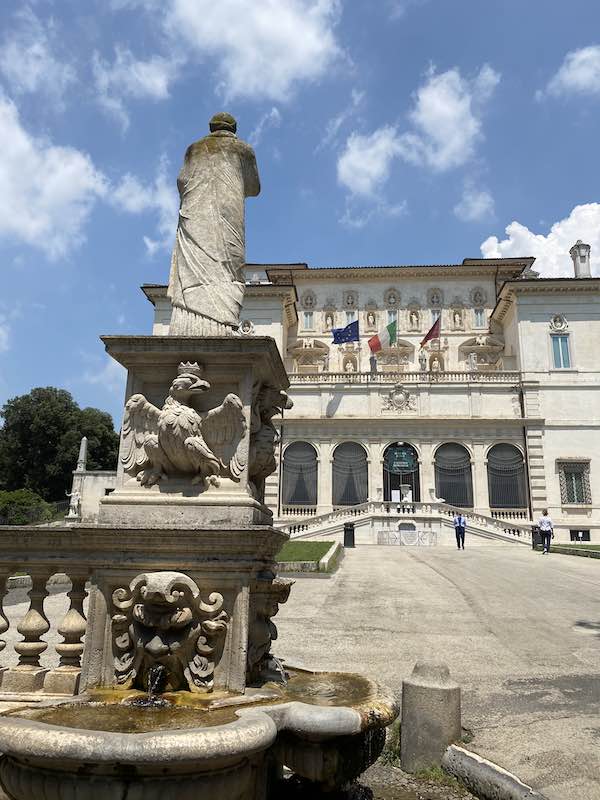All you need to know to plan a visit to the Borghese Gallery: how to get Borghese Gallery tickets, how to get there, what to bring with you (and what to leave home!)
The Borghese Gallery is one of Rome’s most beautiful art museums and one of the most significant art collections in the world.
Started in the XVI century by Cardinal Scipione Borghese, the collection comprises ancient statues, mosaics and a selection of Renaissance and Baroque paintings and sculptures by artists such as Botticelli, Raffaello, Caravaggio, Bernini and Canova.
Some of the most beautiful statues in Rome are here and the setting of the exhibition is so elaborate and aesthetically curated, it is worth a visit in its own right.
The Borghese Gallery is inside Villa Borghese Gardens and it is open to the public via a system of timed entrance.
For art lovers, a visit to the Borghese Gallery is a Rome must-do.
This is all you need to know to plan your visit.
Please note: this post contains affiliate links and, should you make a purchase through them, we might make a small commission.

What is the Borghese Gallery and is it worth visiting?
The Borghese Gallery is a beautiful museum in Rome hosting a unique and extensive collection of sculptures and paintings dating back to ancient times, the Renaissance, the Baroque Era and beyond.
The collection started by hand of Cardinal Scipione Borghese.
Between 1577-1633, the cardinal gathered an incredible number of works of art and became the owner of one of the largest art collections of the time.
The collection is unique for its masterworks’ significance and outstanding aesthetic value.
It is hosted inside a beautiful building and develops across over 20 rooms, decorated with elaborate frescoes and stuccos.
A visit to the Borghese Gallery is unmissable for anyone who loves art but also people who only have a passing interest in it.
The beauty of the location and the pieces is undeniable and the relatively compact size of the gallery makes it easy to add to a Rome itinerary.
Visiting the Borghese Gallery is also a great way to see the works of many artists who made the history of Italian art all in the same place.
In less than two hours, you will be able to see ancient sculptures, statues by masters such as Bernini and Canova and Botticelli and Raffaello, just to mention the best known.
The Gallery is also one of the best places in Rome to see Caravaggio paintings.
All this makes the Borghese Gallery a must-see for art lovers in Rome.

Where is the Borghese Gallery and how to get there
The Borghese Gallery is inside the Borghese Gardens, in Rome city center.
The Galleria Borghese official address is: Piazzale Scipione Borghese 5, 00197 Rome, Italy.
The piazza is inside the park and easy to reach on foot.
The closets park entrances to the Borghese Gallery are on Via Pinciana, Via Mercadante and Via Raimondi.
Via Pinciana entrance is less than two minutes away from the Gallery main door, on foot.
The buses serving the Borghese Gallery are tram 19 and 3, and buses 52, 63, 83, 92, 223, 490, 910.
More in detail:
How to get there by public transportation
From Termini station by bus
- 910 (direction: Mancini)
- 92 (direction: Marliana)
Get off at: Pinciana/Museo Borghese stop
From Flaminio metro station (Line A) by bus:
- 89 (direction Bressanone/ S.Agnese Annibaliano)
- 490 (direction Stazione Tiburtina)
- 495 (direction Stazione Tiburtina)
- 61 (direction Balsamo Crivelli)
- 160 (direction Montagnola)
Get off at: San Paolo del Brasile stop
From Barberini metro station (Line A) by bus:
- 63 (direction Rossellini) fermata Pinciana/Museo Borghese
- 83 (direction Largo Valsabbia) fermata Pinciana/Museo Borghese
- 61 (direction Villa Borghese/ Washington) stop S.Paolo del Brasile
- 160 (direction Villa Borghese/ Washington) stop S.Paolo del Brasile
- 52 direction and stop Pinciana/ Museo Borghese
- 53 direction and stop Pinciana/ Museo Borghese
Getting to the Borghese Gallery by taxi
If arriving to the Gallery by taxi, you can just ask for the museum and they will leave you as close as possible to the entrance.
On your way out, you can find a taxi stand on Via Pinciana and Via Vittorio Veneto.

Borghese gallery opening hours and timed visiting slots
The Gallery is open Tuesday to Sunday from 9.00 am to 7.00pm.
Closed on: Mondays, Christmas day (25th December), 1st January
Visits to the Borghese Gallery are organised in timed slots, to ensure sustainable access and a pleasant experience.
Slots are:
- 09.00-11.00am
- 10.00-12.00
- 11.00-13.00
- 12.00-14.00
- 13.00-15.00
- 14.00-16.00
- 15.00-17.00
- 16.00-18.00
- 17.00-19.00
- 17.45-19.00
You can select your slot at the time of booking.
Need to know: the last slot of the day is slightly shorter. However, this come with a slightly lower ticket cost.
The ticket office opens at 8.30 and closes one hour before closing time.
How to buy Borghese Gallery tickets
You can find here >>> my complete guide on how to buy Borghese Gallery tickets (step by step).
At a glance, there are several way to buy Borghese Gallery tickets:
Ticket booth outside of the gallery: this is only useful in the unlikely event of low affluence to the gallery.
Tickets are usually sold out days if not weeks in advance, so I recommend you plan accordingly and use the online booking options below.
Borghese Gallery official site: an easy option for simple entry tickets (no guided tours in English).
Please note that the system requires you to input personal data.
If this is your first time buying online tickets in Rome, the requests is likely to come across as excessive however, it is pretty standard in the city – if you don’t feel at ease with it, you can you one of the alternative ticket options on this page.
Borghese Gallery Entry Ticket: easy online ticketing option, via the excellent GetYourGuide platform, which offers also free cancellation up to 24h before your visit (always check the small print before purchasing).
This is an excellent way to buy tickets. It often has more availability than the museum website and is an easier purchasing experience.
Borghese Gallery Private Tour: perfect to have the convenience of a private guide leading you through the many wonders of the gallery.
Top tip: while I highly recommend the guided tour of the gallery, I believe you do not need a tour of the gardens, which you can enjoy in your own time. If you pick a tour with flexibility on the exact program, I recommend you ask to focus on the gallery.
Current cost of tickets
- Full rate: 13 Euro
- Reduced rate 18-25 years of age € 2,00
- FREE for under 18 years of age
Ticket prices may increase in case of special exhibitions and events.
A booking fee of 2,00 Euro applies to all bookings.
Important: you need a ticket for each visitor, even those qualifying for free admission. Proof of eligibility to the special price may be required. BRING ID.
How to visit the Borghese Gallery with bags or strollers: need to know
Access to the Gallery is by timed entrance.
Get to the gallery 5 minutes before your slot and wait outside the front door.

The entrance is well signposted and there are kind and helpful staff members helping with admission procedures.
Bags are not allowed inside the museum; anything larger than a small purse must be left at the gallery entrance.
If you have a handbag, you will be asked to leave it at the cloakroom booth in front of the museum.
The cloakroom staff will give you a plastic bag so you can keep your valuables with you.
If you have mobility issues, you can ask the welcome staff for the accessible entrance.
The main entrance currently involves steps but there is an accessible path that they will easily open for you.
Face masks are no longer compulsory inside the museum. However, they are strongly recommended.
Visiting the Borghese Gallery with kids
The Borghese Garden is a traditional art museum and doesn’t currently have kids’ programs in English or interactive areas for young visitors.
On top of this, the Gallery only allows strollers for kids up to age 2.
However, you can easily enjoy it with kids of school age and up.
My favorite way to get my kids to engage with it is to make for them a makeshift scavenger hunt.
Before going in, head to the Gallery Gift shop beside the main entrance and get some postcards with some interesting statues – hand them over to your kids and get them to search for them.
Statues will be easy enough to find but you can add some frescoes and paintings too, to the game a little harder!
If you don’t think the children are up for it, you can also easily divide and conquer: while part of your group visits the gallery, another part can stay in the park and play (or even go to the zoo nearby) and then you switch!
New! The Gallery has finally restarted their family program, although in Italian onl! Now, it is possible to book tickets with a special tour for kids, available on the official gallery site.
A brief history of the Borghese Gallery
The collection that now makes up the Borghese Gallery started in the early years of the XVII century.
In those years, Cardinal Scipione Borghese, nephew of Pope Paul V, commissioned an elegant building to preserve and display his private art collection, comprising of statues and paintings from past and present times.
The building was erected between 1606 and 1616 and follows the same architectural styles of the other suburban villas of Rome from the time, namely Villa Medici, at the other end of the Borghese Gardens, and Villa Farnesina in Trastevere.
The architects Flaminio Ponzio and Giovanni Vasanzio created a light-colored building suitable for the position inside the Borghese Family gardens.
They built a raised portico at the front and decorated the facade with bas-relief and statues that evoked the treasures inside and the nature of the surrounding gardens.
A century later, significant work started on the building by the hands of many architects and artists of the time including Valadier, very active in this part of Rome, and Antonio Asprucci, who turned the building into a work of art in itself thanks to frescoes and interior decorations still visible today.
The singificance of the work by Asprucci is still at the heart of the Gallery as we see it.
He planned the gallery so that each room would have the main piece of art at its center and he planned each room’s decor around the theme of the piece.
This creates a wonderful visitor experience where the observer is fully immersed in the beauty and the significance of the work of art in front of them.
What to see at the Borghese Gallery
The Borghese Gallery is organised on two floors: ground floor and first floor.
Several of the pieces are original from the collection of Scipione while others had to be sold and others got added to the collection in later times.
Things to see in the Borghese Gallery are:
Entrance
The entrance room may or may not be the first one you see when entering the gallery as, in some cases, the visit starts from the second floor.
However, it is a beautiful and significant room.
Its official name is Salone Mariano Rossi and it is decorated with a scene representing ‘Romulus welcome on the Olympus by Zeus, to protect the victory of Furius Camillus on the Gauls’
This theme is interesting if we put it into the context of its creation especially.
At the time, Camillus Borghese was born, who will then marry Paolona Buonaparte, sister of Napoleon!
Ground Floor
The ground floor of the Borghese Gallery has 4 rooms: entrance, Sala della Paolina, Sala del David, Sala di Apollo e Daphne.
Sala in Italian means ‘room’ and ‘del’ means ‘of’.
As you can see from the names, each is named after its main masterpiece:
Sala della Paolina has the statue of Paolina Borghese by Canova.
Paolina is depicted in the guide of Venus and it is surrounded by paintings depicting scenes and stories connected to the Goddess, including the judgment of Paris and the history of Aeneas.
Since its original creation, this room has seen many changes as many of its pieces got moved to the Louvre in Paris under Napoleon.
Sala del David has at its center the stunning statue of David by Bernini, which depicts David as he is just about to throw his stone. The statue is one of the most beautiful in the gallery, in my opinion, and it is a must-see.
Around it, several paintings and reliefs depict scenes from the myth of Phaeton, reason why in the past this room was called ‘the room of the sun’
Sala di Apollo e Daphne takes its name from the very famous statue of Apollo and Daphne sculpted by Bernini, at the center of the room.
The statue is one of the most famous by the artist and it is surrounded by paintings that recall the different moments of the story from this myth, as recounted by Ovidius in the Metamorphosis.
This is another sculpture that you should not miss when visiting the Borghese Gallery for its significance and beauty.
Sala del Sileno: originally named by a Silenus scuplure now at the Louvre, this rooms is outstanding becasue of the presence of several paintings by Caravaggio, including the famous canvases: San Girolamo, Autoritratto in veste di Bacco (Bacchino malato), David con la testa di Golia, San Giovanni Battista, La Madonna dei Palafrenieri and Giovane con canestra di frutta.
First Floor
The first floor of the Borghese Gallery has some sculptures but is mostly devoted to paintings. Not to be missed on this floor are:
Sala di Didone, dedicated to Dido, hosts paintings by Botticelli, Perugino, Andrea del Sarto and Raffaello.
Among the most famous paintings, here is where you can see Raffaello’s Deposition of the Christ, the Dame will Liocorn and Portrait of Man.
Sala di Ercole is dedicated to Hercules and it is known especially for the Danae by Correggio, one of the masterpieces of the Borghese Gallery collection.
Sala della Pittura Ferrarese is entirely devoted to paintings by the school of Ferrara dating from the first half of the XVII century
Sala delle Baccanti hosts paintings from nordic schools and has a replica of a beautiful Leda by Leonardo da Vinci.
Famous masterpieces in the Borghese Gallery: statues and paintings of notice
Among the many masterpieces in the Borghese Gallery, there are some works that also art novices are likely to recognize.
Among the most famous statues in the Borghese Gallery, there are:
- Apollo and Daphne by Gian Lorenzo Bernini,
- The taking of Porseprina, also by Bernini, one of the most famous statues in Rome,
- The statue of David by Gian Lorenzo Bernini
- The group Aeneas, Anchises and Ascanius by Bernini
- The statue of Paolina Borghese by Canova
- Amor Sacro and Amor Profano painting by Titian,

The 6 paintings by Caravaggio in the Borghese Museums are Palafrenieri’s Madonna, Davide with the head of Goliath, Youngster with basket of fruit, the so called ‘Bacchino malato’, San Gerolamo and San Giovannino.
The paintings by Raffaello in the Gallery include the Dame with Liocorn, the deposition of Christ and the ‘portrait of a man’, depicted with distinctive black frock and hat.
Correggio’s Danae is in the Gallery, and it is peculiar also for the theme chosen, that of Danae mother of Perseus, not often depicted at the time.
What to wear to visit the Gallery
To visit the Borghese gallery, I highly recommend you wear a comfortable pair of shoes and leave home bulky bags.
The shoes will keep you comfortable in the museum and also allow you to visit the Borghese Gardens with ease and a small bag will save you from having to queue at the wardrobe upon entering.
Food and drinks are not allowed in the gallery: several cafes are in the park as well as drinking fountains.
Hand gel is provided upon entrance. Photographs inside the Gallery area allowed (no flash).
The Borghese Gallery in Rome, essential guide – pin this!

This article was originally published in 2021 and has now been fully updated.
